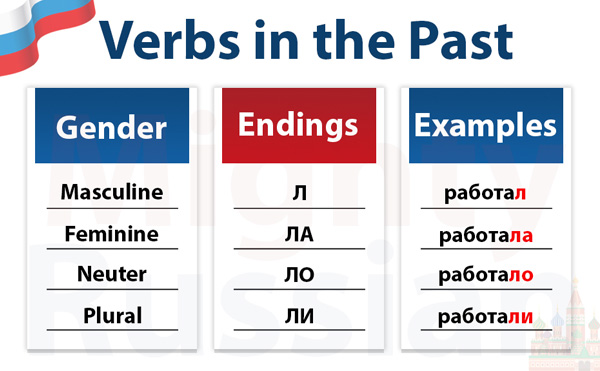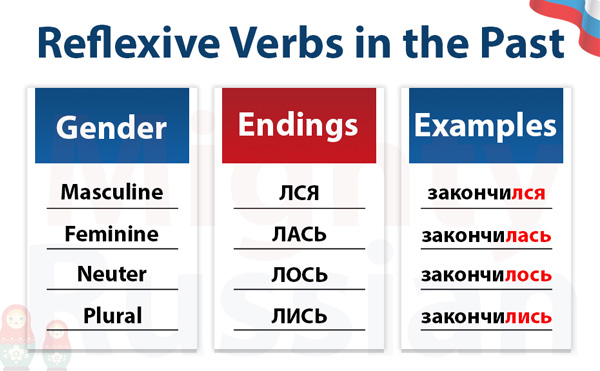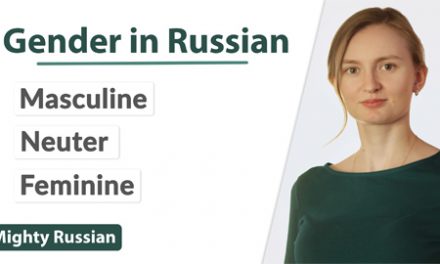It seems that you are looking at an outdated version of this lesson.
Click here to see the latest version of it, which includes examples with audio, integration with our dictionary and exercises.
The Past Tense in Russian
The Russian language has 3 verb tenses: Present, Future and Past.
Anyone who wants to speak Russian fluently must know all of them.
In this lesson, we will learn the past tense, which is the easiest one.
I will first explain when you should use the past tense in Russian.
Then, you will learn how to form sentences using the past tense.
When to use the past tense in Russian
Unlike in English, there is only one past tense in Russian.
This makes the past tense in Russian very easy.
Just take a fast look at the following sentences in English:
I studied English (Я учил английский)
I was studying English (Я учил английский)
I would study English when I was a kid (Я учил английский, когда был ребёнком)
I used to study English (Я учил английский)
I have studied English (Я учил английский)
I had studied English before I traveled to the US (Я учил английский перед тем, как поехал в США)
These sentences can all be translated into Russian using one single verb tense.
This means that, when you speak Russian, you don’t have to think about when or how something happened in the past in order to choose the right tense.
Basically, as long as something happened before “now”, you will use the past tense.
Unfortunately, there is one detail you have to be careful with.
In Russian, verbs are divided into perfective and imperfective.
You will use a perfective verb if an action was completed and an imperfective verb if an action was not completed.
A perfective verb focuses on the result of an action, while an imperfective verb focuses on the process.
For example:
Я учил английский
Я выучил английский
Both sentences mean “I learnt English”.
Note that the verb tense is the same, the past.
However, the first sentence means that you just spent some time learning English.
While the second one focuses on the result and means that you have already learnt English and now you are fluent.
We can see this difference in the meaning because one verb is perfective and the other one is imperfective.
If you don’t know how to use Perfective and Imperfective verbs in Russian, make sure to check out our complete lesson about this subject clicking here.
How to form the past in Russian
Almost every Russian verb in the infinitive form ends in “ТЬ” or, if it is reflexive, in “ТЬСЯ” (the infinitive is the dictionary form of the verb).
For example:
спать (to sleep)
учить (to study)
просыпаться (to wake up)
смеяться (to laugh)
If you don’t know what Reflexive Verbs are or when to use them, you can check out our complete lesson about this subject clicking here.
The way we put reflexive and non-reflexive verbs into the past is almost the same.
But to make sure everything is easy to understand, let’s learn how to put them into the past separately.
Non-reflexive verbs in the past
To put verbs that end in “ТЬ” into the past, you just have to replace the ending “ТЬ” with “Л”, “ЛА”, “ЛО” or “ЛИ”.
01) When the subject is masculine, you will use “Л”.
For example:
Он работал целый день (He worked the whole day)
Мальчик учил вчера английский (The boy studied English yesterday)
Джон ходил в супермаркет (John went to the supermarket)
02) When the subject is feminine, you will use “ЛА”. For example:
Она помыла машину (She washed the car)
Девушка смотрела фильм (The girl watched a movie)
Мэри много путешествовала (Mary has traveled a lot)
03) When the subject is neuter, you will use “ЛО”.
For example:
Море шумело (The sea was making noise)
Время пролетело быстро (The time went by fast)
Блюдо было хорошим (The dish was good)
04) When the subject is in the plural, you will use “ЛИ”.
For example:
Мы ездили во Францию (We traveled to France)
Они приготовили вкусный ужин (They cooked a delicious dinner)
Мужчины играли в футбол (The men were playing soccer)
Note that when a noun is in the plural, it doesn’t matter if it’s masculine, feminine or neuter, the ending of the verb is “ЛИ”.
If you are not familiar with the concept of gender in Russian, you can check out our complete lesson about it clicking here.
Reflexive verbs in the past
To put verbs that end in “ТЬСЯ” into the past, you just have to replace the ending “ТЬСЯ” with “ЛСЯ”, “ЛАСЬ”, “ЛОСЬ” or “ЛИСЬ”.
01) When the subject is masculine, you will use “ЛСЯ”.
For example:
Он проснулся поздно (He woke up late)
Мальчик собрался вовремя (The boy got ready on time)
Майк вчера много занимался (Mike studied a lot yesterday)
02) When the subject is feminine, you will use “ЛАСЬ”.
For example:
Она готовилась к школе (She was preparing for school)
Женщина проснулась в 7 утра (The woman woke up at 7 a.m.)
Дженни причесалась (Jenny brushed her hair)
03) When the subject is neuter, you will use “ЛОСЬ”.
For example:
Солнце скрылось за горизонтом (The sun hid behind the horizon)
Море волновалось (The sea was agitated)
Всё закончилось хорошо (Everything ended well)
04) When the subject is in the plural, you will use the ending “ЛИСЬ”.
For example:
Они поссорились (They fought)
Дети помирились (The kids made peace)
Мы учились в школе (We were studying at school)
And that’s all! Now you know how to use the past tense in Russian.
I hope everything got clear, but if you have any questions, just leave them in the comment section below.
I will be very happy to help you!















Привет дарагоя Анастасия
Сгодится я хочу очень смотреть и работать на твоя саит потому что мне нужно грамер.
Спасибо за помощь.